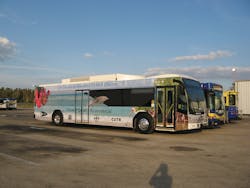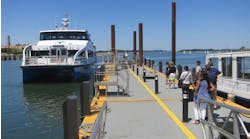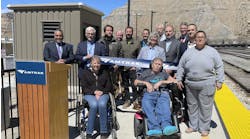Lee County Transit, known as LeeTran, operated by Lee County is responsible to the Lee County Board of County Commissioners. LeeTran currently operates 17 bus routes. Sixteen of the bus routes operate on a scheduled fixed-route system at least six days per week. Six routes operate on Sundays. One route provides limited express bus service, by reservation, to Pine Island on Thursdays only.
LeeTran provides trolley service, branded as the “Trollee” along Fort Myers Beach and provides park-and-ride service connecting to the Fort Myers Beach trolley. The trolley system operates increased service during the peak season and a reduced schedule during off-peak season.
Going Hybrid
LeeTran collaborated with ISE, CUTR, FTA and the Florida Department of Transportation and Coach Crafters Inc. to build a gasoline hybrid bus. The goal of this partnership and project was to utilize different stakeholders and come together to build and operate a transit bus with zero emissions. Additionally, LeeTran wanted to incorporate the ISE power plant specifically in the design to test the propulsion system and fuel economy against other hybrid propulsion technologies.
This was a demonstration project and a collaborative effort of many people from Florida to California to retrofit an existing bus with a gasoline engine and a state-of-the-art propulsion system from ISE. LeeTran chose a Gillig 40-foot BRT package bus to be retrofitted for this project teamed up with a Ford V-10 gasoline engine and the ISE propulsion system. The propulsion system is unique in the sense that it does not use batteries to store electrical power for the drive motors. It utilizes the gasoline engine to power a Siemens generator that subsequently charges a super capacitor, which in turn sends power to a set of Siemens electrical drive motors connected to the existing drive train. (There is no driveline connection between the gasoline engine and the drive train.) This system also has the unique ability of utilizing the drive motors to act as generators during braking to maximize braking, and capitalize on electrical power generated from braking.
Meetings on Design
During the initial design of this new hybrid bus, the LeeTran maintenance manager and a senior technician from LeeTran visited the factory in California where the hybrid was constructed. This visit led to a series of collaborative meetings between ISE technical staff and LeeTran maintenance staff to train technicians on its systems. LeeTran Maintenance Manager Larry Ralston quickly identified the complexity of the system and chose one of his best technicians to be the project technical liaison for his team. Additionally, Coach Crafters Inc. of Tavares, Fla., was chosen as the vendor to provide local warranty support for the ISE systems.
Unlike the operations training, the maintenance training required in-depth explanations of the various systems since the ISE Hybrid technology encompasses many different and new electrical components that are not found in conventional diesel buses. ISE personnel were very helpful in providing on-site training and guidance throughout all phases of the project.
Moreover, it proved to be an important element before, during and after the completed project. Advances in new hybrid technologies while pertinent will present new challenges to maintenance personnel and transit systems alike.
Need for Specific Training
LeeTran personnel recognized the need for specific training (relating to the ISE technology) for bus operators, supervisors and maintenance employees. Moreover, Lee Tran staff reached out to local emergency responders to invite teams of firefighters and first responders alike to attend specialized training on this new vehicle.
Operations and maintenance department managers teamed up to accomplish basic training for bus operators as well as mechanics. ISE representatives were available during the training to promote safety awareness when working around high voltage lines and the super capacitor.
With the addition of this new gasoline hybrid bus, the operations department launched a training campaign for supervisors initially followed by lead bus drivers and finally bus operators. LeeTran quickly determined that the person conducting the orientation and driver training for this new bus needed fully to understand the propulsion system and the re-genitive braking systems respectfully.
Supervisors were required to attend training sessions with ISE representatives and technicians to provide them with firsthand information relating to the safety and operational functions of the propulsion system. Technicians pointed out high voltage wiring (color coded orange), power disabling capabilities, internal engine compartment components as well as starting and shut down procedures.
Road testing the hybrid bus with ISE staff proved to be pertinent as well, since this presented the opportunity for the technicians to explain what was happening while driving the vehicle, while it was happening. The regenerative braking system of the propulsion system is unique and utilizes the drive motors as well as other components to slow the bus down, adding to the efficiency of the fuel economy.
LeeTran staff quickly identified the importance of behind-the-wheel training for every operator, supervisor and maintenance worker so they could become acclimated to the acceleration and stopping characteristics of this new vehicle. Supervisors were required to drive the vehicle on the road to obtain a feel for the regenerative braking system and experience the propulsion from a stopped position. The propulsion system accelerates very well and takes some getting used to when operating in the transit environment.
Operator Training
Once the supervisory and maintenance staff personnel were trained on the hybrid, it was time to turn the attention to the bus operators. The operations department wanted to be certain that all safety information and the various systems were covered with all operators. Since this was the first BRT package bus as well as LeeTran’s first hybrid vehicle, orientation for both of these elements was combined into one training session.
Each bus operator was required to attend a training session that included a road test with the operator driving the hybrid bus on city streets in the transit environment. Each operator was also required to complete a comprehensive vehicle orientation that included a walk around and a lecture about the various electrical systems, the propulsion system and all safety features. Awareness was provided to operators about utilizing proper driving habits during inclement weather, stopping distances, acceleration differences between a conventional diesel bus, deceleration differences between conventional buses and finally overall safe operation of the vehicle.
Training Results
Overall, the training went very well and from an operational perspective, there were very few differences in learning to operate the new hybrid vs. a conventional diesel bus. The two most important elements to drive home to bus operators is the vehicle’s ability to accelerate very good from a dead stop and the regenerative braking system that feels much like a retarder but is substantially more efficient at stopping the vehicle.
During the initial testing of the vehicle performance, LeeTran realized that the overall efficiency of the fuel economy is directly related to the way the vehicle is driven and the environment that it is driven in. It became important to LeeTran to provide the operators with examples of how it wanted the vehicle to be driven during training so it could benefit fully from the regenerative braking and super capacitor technologies. The propulsion system that ISE utilizes in this bus capitalizes on stop and go movement as well as braking to maximize overall efficiency and fuel economy.
It is worth mentioning that LeeTran received very positive feedback from its bus operators regarding the operation of the hybrid bus. Additionally, the vehicle is holding up very well-operating long hours daily. ISE has demonstrated its dedication to this project by providing an ongoing partnership and collaborative effort with LeeTran personnel.
Paul Goyette is the Operations Manager for Lee County Transit.



